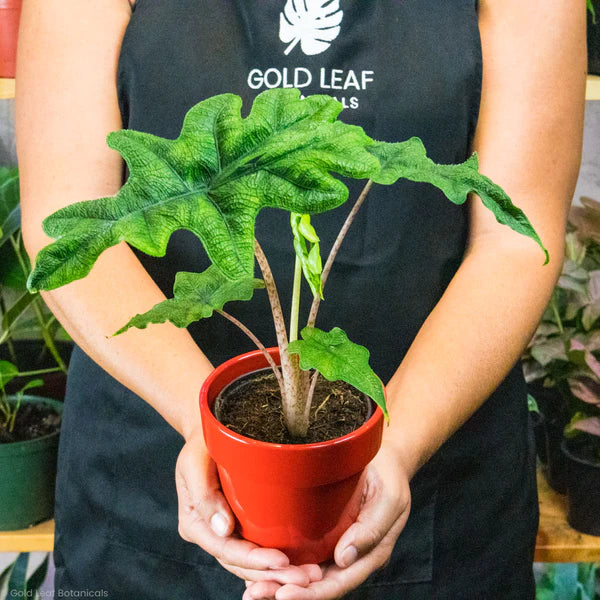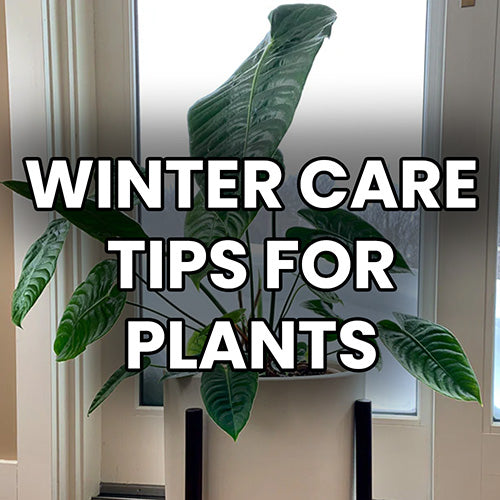
Alocasia Care: The ULTIMATE Guide to the Elephant Ear Plant
Share this with friends
Alocasia care is a breeze, and individuals of all age groups can effortlessly cultivate them. We have curated this resource to lend a hand.
We refer to Alocasia, alternatively recognized as the pachyderm foliage plant, a tropical specimen admired by flora enthusiasts for its expansive, lustrous leaves and captivating aspect.
Within our comprehensive manual for Alocasia care, you will acquire all the essential knowledge to maintain the vigor and allure of your Alocasia plant.
Alocasia represents a plant genus within the arum family, indigenous to tropical areas of Asia and Australia. Renowned for their grandiose, glossy leaves resembling an elephant's auricle, hence their moniker.
Aside from their aesthetic charm, Alocasia plants possess noteworthy air-filtration properties, enhancing the quality of indoor atmospheres.

Alocasia plants come in many different varieties and can range in size from small tabletop plants to large, imposing specimens. The leaves can be smooth or textured, and come in a range of colors including green, black, and even metallic hues.
Some Alocasia plants also have striking white veins running through the leaves.
In this guide, you will learn how to choose the right Alocasia plant for your home, the best potting and soil methods, lighting and watering techniques, fertilizing schedule and how to identify and solve common problems that Alocasia plants may face.
By the end of this guide, you will be an Alocasia pro, able to keep your elephant ear plant thriving for years to come.
Choosing the Perfect Alocasia Plant
Choosing an Alocasia plant can be tough because they all look so good! There are many different styles to choose from, each coming with its own unique look.
Alocasia Varieties
Alocasia plants come in many varieties such as
- Alocasia Jacklyn (our most popular!)
- Alocasia Silver Dragon
- Alocasia Sinuata
- Alocasia Bisma
As well as many others. Each variety has its own unique leaf shape and pattern. Some are large and imposing, while others are small and compact.
Care You Will Provide
In general, Alocasia plants prefer bright, indirect light and high humidity. Providing proper light is the most important consideration when you buy an Alocasia plant. High humidity can be found in kitchens and bathrooms. Some growers mist their Alocasia to keep humidity levels high.
Lighting for an Alocasia plant
Proper lighting is crucial for the health and growth of an Alocasia plant.
Read our COMPLETE guide on the best LED lights for indoor plants. Give your plants the boost they want with proper lighting.
Alocasia plants prefer bright, indirect light to grow to their full potential. Yes, they can tolerate lower light levels, but they will not really thrive in low light conditions.
Direct sun is bad for your Alocasia
It's important to remember that direct sunlight will scorch the leaves, so place the plant in a spot where it will receive filtered light.
If you don't have a spot in your home that receives the right amount of light, you can supplement with grow lights.
Check in on Your Alocasia
To ensure that your Alocasia plant is getting the right amount of light, keep an eye on the plant's leaves. If the leaves are a dark green colour, the plant is getting the right amount of light and you don't have to make any changes.
If the leaves are yellow or losing their colour, then the plant is not getting enough light. We like to remind grower to rotate their plants occasionally to ensure that all sides receive an equal amount of light.
Watering an Elephant Ear Plant
Watering is a crucial aspect of Alocasia care, as the plant is susceptible to both over- and under-watering. In terms of watering requirements, the soil should be consistently moist but not waterlogged.
Understanding Alocasia Water Needs
The best way to ensure this is to use the finger test; stick your finger into the soil up to the first knuckle, if the soil feels dry, it's time to water.
Humidity Requirements
It's important to note that Alocasia plants prefer high humidity, so misting the leaves regularly can be beneficial.
When it comes to properly watering an Alocasia, it's best to use room temperature water and avoid getting water drops on the leaves. While mist is okay, a water droplet may cause a "leaf spot".
How to Water An Alocasia
A good method is to water the soil directly at the base of the plant. Allow the water to soak through the plant so it reaches the roots.
Let your plant drain off the excess water before placing it into the decorative pot.
Common Watering Mistakes
The most common watering mistakes we see with Alocaisa plants is over-watering, which will lead to root rot and yellowing. U
On the other hand, under-watering can cause leaves to droop and become dry.
Proper Drainage is Needed for Strong Roots
A big mistake we have seen is not allowing proper drainage! The holes in the bottom of plastic grower pots let excess water in the soil drain, preventing waterlogged soil and root rot.
Over time you will learn your Alocasia, and you can stick to a consistent watering schedule, paying attention to the moisture levels in the soil.
Potting and Soil for Elephant Ear plants
Potting and soil is essential for keeping your Alocasia plant healthy.
Alocasia plants prefer a well-draining soil. We prefer a mixture of soils and barks as that mimics the conditions the plant sees in nature.
Drainage Holes are Needed
As we mentioned earlier, Alocasia plants prefer a pot with drainage holes in the bottom so the water can drain and the soil doesn't hold too much water, as that causes root rot.
It's important to choose the correct size of pot, however your Alocasia will not need to be re-planned often, if ever.
Repotting an Alocasia to a Bigger Pot
Repotting an Alocasia plant should be done with care, and only when it has outgrown its pot, and become root bound. It's also possible that the soil has become depleted and it's all roots.
Be careful and handle your Alocasia gently when repotting. Ensure you don't damage the roots when you do this. When it's in its new pot, make sure it is firmly planted in the new soil.
Fertilizing Your Alocasia Plant
Fertilizing an Alocasia plant helps provide it with the necessary nutrients for fast growth and deep greens. A balanced, water-soluble fertilizer with a ratio of 20-20-20 is ideal for Alocasia's, and it should be applied monthly during the growing season. Alocasia plants prefer a well-draining potting soil.
It's crucial to prevent over-fertilizing an Alocasia plant because this can result in leaf burn and root damage.
How to Fertilize an Alocasia Plant
Apply your fertilizer to the soil, diluted to half the recommended dosage, being careful not to get any on the leaves.
Please remember, you should only add fertilizer when the soil is already damp. If the soil is dry, the fertilizer could burn the roots of your plants.
Types of Fertilizers
The best fertilizers for Alocasia plants are those that are balanced, water-soluble, and contain a ratio of 20-20-20.
These fertilizers provide the plant with the necessary nutrients for healthy growth, including nitrogen for leaf growth, phosphorus for root development, and potassium for overall health and vigor. Some popular options we use at our shop is Liquidirt, and Bios Plant Fertilizier.
Common Elephant Ear Problems
Despite their amazing looks, Elephant ear plants can be prone to a number of common problems, including brown or yellow leaves, leaf drop, wilting, and root rot.
If you think your Alocasia plant is experiencing any issues, the first step is to properly diagnose the problem.
Alocasia leaves turning yellow or brown
Brown or yellowing leaves can be caused by a number of factors, including over-watering, under-watering, or exposure to direct sunlight.
Alocasia Leaves Wilting
Similarly, wilting can be caused by a lack of water or a pest infestation. Inspect your plant thoroughly to see which one is likely causing the problem. Once you have diagnosed the issue you can then take the appropriate steps to treat it.
If your plant is suffering from over-watering, you may need to reduce the frequency of watering.
On the other hand, if your plant is suffering from under-watering, you will need to increase the frequency of watering, and keep an eye on how it is responding.
Preventative Maintenance is Key
The best way to deal with common Alocasia plant problems is to prevent them from occurring in the first place. That's easier said than done!
Some tips for preventing problems include providing your plant with the right amount of light, water, and humidity, using a well-draining potting mix, and keeping an eye out for pests or disease.
With proper care and attention, you can help ensure that your Alocasia plant remains healthy and beautiful for years to come.
Conclusion
In this Alocasia care guide, we have covered the important steps of caring for an Alocasia plant.
To sum up the key takeaways from this guide; provide the right amount of light, water, and humidity, using a well-draining potting mix, and be aware of common problems and how to prevent them.
Regularly check the soil moisture level and make adjustments as needed. Keep an eye out for common problems we reviewed, and take action to address them as soon as they arise.
By following these tips and implementing the advice covered in this guide, you can help ensure that your Alocasia plant remains healthy and beautiful for years to come.
Now that you have a better understanding of how to care for an Alocasia plant, it is important to put this knowledge into practice.





